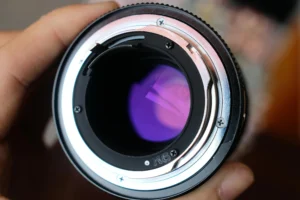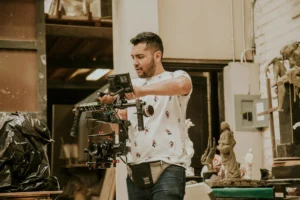What lenses do I need for filmmaking?

Filmmaking is a creative activity in which the narrative depends much on images. A flexible lens set is among the most valuable instruments a director may have. Lenses help your scene to feel, appear, and captivate your viewers. They affect not just the field of vision but also the perspective, the degree of background blurriness, and the general cinematic quality.
Knowing the lenses you require will either help or destroy your production quality, regardless of your level of experience as a filmmaker entering professional projects. This article will address some of the most often asked questions filmmakers have concerning lenses, along with important lenses for filmmaking and tips on selecting the correct ones for your purposes.
Learning Focal Length and Aperture
Understanding two keywords will help you appreciate the list of lenses.
The focal length (mm) will define the width or tightness of your photograph. Higher focal lengths (85mm, 200mm) provide closer, zoomed-in views; lower focal lengths (14mm, 24mm) provide wide-angle views.
Aperture, also known as f-stop, regulates the light entry of the lens. Reduced values, such as f/1.4, suggest a larger aperture that permits more light and generates a narrow depth of focus (blurred backgrounds).
Filmmaking’s Essential Lenses
Standard Zoom Lens, 24-70mm or 24-105mm
Why should you have it?
These are the Swiss army knife lenses. Perfect for most circumstances including interviews, events, b-roll, run-and-gun filming, the 24-70mm or 24-105mm lens covers wide-angle to medium telephoto images.
Best use cases:
- Establishing views
- Interviews
- Videos documentaries
- Cover of events
Suggestive glasses:
- Canon RF/EF 24-70mm f/2.8L II
- Sony’s 24-70mm f/2.8 GM
- Sigma 24–70mm f/2.8 Art
Two wide-angle lenses:
16–35mm or 14–24mm.
Your need for it:
A wide-angle lens is crucial for settings where you want to capture the surroundings, tight inside areas, or add dramatic viewpoints. Increased foreground and backdrop distance generates an immersive experience.
Best use cases:
- Vidging
- Real-estate videos
- Travel films
- Scenes in cars and action films
Suggested eye lenses:
- Canon 16-35mm f/2.8L III.
- 16-35mm f/2.8 GM Sony
- Sigma 14-24 mm f/2.8 Art
Three fast prime lenses:
35mm, 50mm, 85mm.
Why should you have them?
While they have set focal lengths, prime lenses provide better pictures and apertures than zoom lenses. Perfect for cinematic views, portraiture, and creative images, they have a lovely shallow depth of field.
Possible primitives:
- Perfect for handheld sequences, street films, and environmental portraiture, 35mm f/1.4 or f/1.8.
- Offers a natural field of vision, perfect for interviews and narrative storytelling, 50mm f/1.4 or f/1.8 (“Nifty Fifty”.
- Best for close-ups, interviews, and dramatic portraits with creamy backgrounds—85mm f/1.4 or f/1.8.
Suggested lenses:
- Canon f/1.2L RF/EF 50mm
- Sony 50mm f/1.4 GM
- Sigma 35 mm f/1.4 Art
- 4.70–200mm Telephoto Zoom Lens
Why must you have it?
By compressing the backdrop, telephoto lenses let you catch subjects from a distance, therefore enhancing the dramatic and personal impression of situations. For sports, wildlife, and live events, it’s a must-have perspective.
Ideal use cases:
- Events include concerts and live presentations.
- Nature and animal life
- Athletics
- Emotional close-ups done from a distance
Advised lenses:
- F/2.8L Canon 70-200mm IS III
- Sony70-200mm f/2.8 GM OSS
Macro Lens:
90mm, 100mm, 105mm
Why do you want it?
Product videography, culinary photography, and creative b-roll sequences all depend on macro lenses as they are meant to capture rather close-up views with great clarity.
Best use cases:
- Product evaluations
- Food camera photography
- Documentaries on insects and the environment
- Innovative texture shots
Suggested eye lenses:
- Macro IS 100mm f/2.8L Canon
- Sony 90mm f/2.8 Macro OSS
- Optimal Lenses (Optional)
1. Movie Lenses
Specifically designed for filmmaking are cine lenses. They use exact manual controls, no focus breathing, and geared focus and aperture rings.
Popular optical lenses for movies:
- Rokinon DTV
- Sigma Cinema Prime
- Zeiss CP-3
2. Lenses with anamorphic focus
With their distinctive lens flares and oval bokeh, anamorphic lenses provide a wide cinematic aspect ratio that will help your movie have “Hollywood look.”
Popular choices are:
- Sirui Anamesic
- Vazen Anamesic
3. Tilt-Shift Lenses and Fisheye
Mostly utilised for artistic images, architecture, or stylistic sequences, these lenses serve
- For beginners, choose lenses based on filmmaking style 24-70mm f/2.8 (all-purpose).
- 50mm f/1.8 (cinema and reasonably priced)
- Versatile 24-70mm f/2.8 for documentary filmmakers
- 70–200mm f/2.8 (candid views and interviews)
- Low-light scenes on 35mm f/1.4
- For filmmakers working on narratives, 35mm, 50mm, and 85mm
- wide-angle lens to create photos
- For vloggers and YouTubers: 16–35mm f/2.8 (Wide-angle)
More Advice about lenses for filmmaking
- Put money into lenses over bodies. While excellent lenses survive decades, camera bodies fall out of favor quickly.
- Many independent filmmakers acquire a distinctive appearance by using antique lenses such as old Canon FD or Helios 44-2.
- Not overlooked are ND filters and lens hoods, which help to regulate exposure and reduce glare.
- Start small; you won’t need all the lenses at once. Start with a 24-70mm quick prime and progressively build your kit.
- If you shoot on mirrorless, you can attach older DSLR or movie lenses using adapters sensibly.

Five frequently asked questions (FAQs).
Q1. For filming, which is the greatest initial lens?
The ideal all-purpose first lens is a basic zoom lens such as the 24–70mm f/2.8. It works with almost any kind of shooting and spans from broad to medium telephoto.
Q2. Does filmmaking call for prime lenses?
Prime lenses are frequently sought after for narrative films and interviews even if they are not required as they provide clearer pictures, superior low-light performance, and a cinematic narrow depth of vision.
Q3. Is it OK to use photographic lenses for video?
Indeed. Many directors use photographic lenses. Still, cine lenses are best suited for filming and provide more seamless manual capabilities.
Q4. Using kit lenses, can I film?
Indeed, but compared to premium lenses, kit lenses—such as 18-55mm f/3.5-5.6—often are slower and less crisp. For novices, they are OK; yet, upgrading to faster lenses will clearly enhance your film.
Q5. Are films requiring anamorphic lenses really necessary?
Though they have a distinctive widescreen image, lens flares, and oval bokeh that many connect with high-end film, they are not absolutely essential. For imaginative narrative, it’s a fantastic inclusion, depending on the budget.
Conclusion
Selecting the correct lenses for filmmaking strikes a compromise between your budget, artistic vision, and the kinds of films you want to make. Starting with a simple zoom and prime lens will not limit your creative possibilities; rather, extending your collection over time will provide fresh ideas.
Remember, the way you utilise the lens determines the cinematic magic rather than just its quality. Top, learn your gear; next, play around with focal lengths and give narrative top priority.